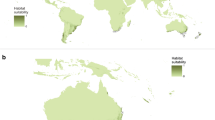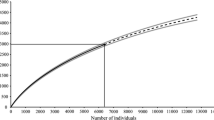Abstract
The ability to determine the spatial distribution of rare fungal species is critical to understanding the environmental factors that affect them. Maximum entropy (MaxEnt) spatial distribution modeling solves this problem by allowing inferences about the distribution of species in a gradient of environmental factors based on occurrence data. To identify patterns of spatial distribution based on objective data, models of the potential geographical distribution of the rare polyporoid fungus of Picipes rhizophilus under current conditions (~1950–2000) and with predicted future climate changes (2100 AD) on a global scale have been created. The species Picipes rhizophilus can develop in steppe habitats of both plains and mountains. Most known habitats of the species are found in the ecoregions that make up the temperate grasslands, savannas and shrublands, Mediterranean forests, woodlands and scrubs, and desert and xeric shrubland biomes. The species is not associated with forest biomes, but it can be found in habitats located on their territory, subject to the processes of climate aridization and desertification. The species Picipes rhizophilus can develop in steppe habitats of both plains and mountains. Modeling the potential distribution of the species under the selected climatic scenario has shown the dynamics of changes in its range. The species-friendly climate area will increase in the North American continent, while there will be no significant changes in Europe and adjacent areas of Africa. In the most favorable territory for the species, located in the basin of the Western Manych River, conditions will become less favorable. There will be a local shift in the areas of potential distribution in the Asian part.




Similar content being viewed by others
REFERENCES
Chapman, D.S. and Purse, B.V., Community versus single-species distribution models for British plants, J. Biogeogr., 2011, vol. 38, no. 8, pp. 1524–1535.
GBIF. The Global Biodiversity Information Facility. 2023. https://www.gbif.org. Cited January 15, 2023.
Guisan, A. and Thuiller, W., Predicting species distribution: offering more than simple habitat models, Ecol. Lett., 2005, vol. 8, no. 9, pp. 993–1009.
Guisan, A. and Zimmermann, N.E., Predictive habitat distribution models in ecology, Ecol. Modell., 2000, vol. 135, nos. 2–3, pp. 147–186.
Guo, Y., Li, X., Zhao, Z., Wei, H., Gao, B., and Gu, W., Prediction of the potential geographic distribution of the ectomycorrhizal mushroom Tricholoma matsutake under multiple climate change scenarios, Sci. Rep., 2017, vol. 7, p. e. 46221.
Hijmans, R.J., Cameron, S.E., Parra, J.L., Jones, P.G., and Jarvis, A., Very high resolution interpolated climate surfaces for global land areas, Int. J. Climatol., 2005, vol. 25, pp. 1965–1978.
Hijmans, R.J., Guarino, L., and Mathur, P., DIVA-GIS Version 7.5 Manual. http://diva-gis.org/docs/DIVA-GIS_manual_7.pdf. Cited January 15, 2023. https:// hub.arcgis.com/datasets/a21fdb46d23e4ef896f3147521 7cbb08_1/data?geometry=-99.844%2C-89.998%2C99. 844%2C-79.394. Cited January 15, 2023. https://www. arcgis.com/apps/View/index.html?appid=d60ec415feb b4874ac5e0960a6a2e448. Cited January 15, 2023. https://www.arcgis.com/apps/View/index.html?appid= d60ec415febb4874ac5e0960a6a2e448. Cited January 15, 2023. https://www.diva-gis.org/. Cited January 15, 2023. https://www.diva-gis.org/climate. Cited January 15, 2023. https://www.diva-gis.org/Data. Cited January 15, 2023. https://www.worldwildlife.org/publications/terrestrial-ecoregions-of-the-world. Cited January 15, 2023.
Olson, D.M., Dinerstein, E., Wikramanayake, E.D., Burgess, N.D., Powell, G.V.N., Underwood, E.C., D’amico, J.A., Itoua, I., Strand, H.E., Morrison, J.C., Loucks, C.J., Allnutt, T.F., Ricketts, T.H., Kura, Y., Lamoreux, J.F., Wettengel, W.W., Hedao, P., and Kassem, K.R., Terrestrial Ecoregions of the World: A new map of life on Earth: A new global map of terrestrial ecoregions provides an innovative tool for conserving biodiversity, BioScience, 2001, vol. 51, no. 11, pp. 933–938.
Phillips, S.J. and Dudík, M., Modeling of species distributions with MaxEnt: new extensions and a comprehensive evaluation, Ecography, 2008, vol. 190, pp. 231–259.
Phillips, S.J., Anderson, R.P., and Schapired, R.E., Maximum entropy modeling of species geographic distributions, Ecol. Modell., 2006, vol. 190, pp. 231–259.
Pietras, M., Litkowiec, M., and Gołębiewska, J., Current and potential distribution of the ectomycorrhizal fungus Suillus lakei ((Murrill) A.H. Sm. et Thiers) in its invasion range, Mycorrhiza, 2018, vol. 28, pp. 467–475.
Sandanov, D.V. and Naidanov, B.B., Spatial modeling of the ranges of East Asian plant species: current state and dynamics under the influence of climate change, Rastit. Mir Aziat. Ross., 2015, vol. 3, no. 19, pp. 30–35.
Sandanov, D.V. and Pisarenko, O.Yu., Bioclimatic modeling of Crossidium squamiferum (Viv.) Jur. (Pottiaceae, Bryophyta) distribution, Arctoa, 2018, vol. 27, pp. 29–34.
Scheldeman, X. and Van Zonneveld, M., Training manual on spatial analysis of plant diversity and distribution, Rome: Biodiversity Int., 2010, pp. 1–179. https:// www.bioversityinternational.org/fileadmin/_migrated/ uploads/tx_news/Training_manual_on_spatial_analysis_ of_plant_diversity_and_distribution_1431_07.pdf. Cited January 15, 2023.
Segurado, P. and Araújo, M.B., An evaluation of methods for modelling species distributions, J. Biogeogr., 2004, vol. 31, pp. 1555–1568.
Vlasenko, V.A., Dejidmaa, T., Dondov, B., Ochirbat, E., Kherlenchimeg, N., Javkhlan, S., Burenbaatar, G., Uranchimeg, A., Asbaganov, S.V., and Vlasenko, A.V., Distribution and ecological niche modeling of a rare species Poronia punctata in Asia, Curr. Res. Environ. App-l. Mycol., 2021, vol. 11, no. 1, pp. 468–484.
Yuan, H.-Sh., Wei, Yu.-L., and Wang, X.-G., Maxent modeling for predicting the potential distribution of Sanghuang, an important group of medicinal fungi in China, Fungal Ecol., 2015, vol. 17, pp. 140–145.
Zurell, D., Franklin, J., König, C., Bouchet, P.J., D-ormann, C.F., Elith, J., Fandos, G., Feng, X., Guillera-Arroita, G., Guisan, A., Lahoz-Monfort, J.J., Leitão, P.J., Park, D.S., Townsend Peterson, A., R-apacciuolo, G., Schmatz, D.R., Schröder, B., Serra-Diaz, J.M., Thuiller, W., Yates, K.L., Zimmermann, N.E., and Merow, C.A., A standard protocol for reporting species distribution models, Ecography, 2020, vol. 43, no. 9, pp. 1261–1277.
Funding
This work was carried out in accordance with the State Task of the Central Siberian Botanical Garden of the Siberian Branch of the Russian Academy of Sciences AAAA-A21-121011290024-5.
Author information
Authors and Affiliations
Corresponding author
Ethics declarations
The authors declare that they have no conflicts of interest.
Rights and permissions
About this article
Cite this article
Vlasenko, V. Features of the Geographical Distribution of the Rare Fungi Picipes rhizophilus (Basidiomycota) in a Changing Climate. Contemp. Probl. Ecol. 16, 451–457 (2023). https://doi.org/10.1134/S1995425523040133
Received:
Revised:
Accepted:
Published:
Issue Date:
DOI: https://doi.org/10.1134/S1995425523040133




